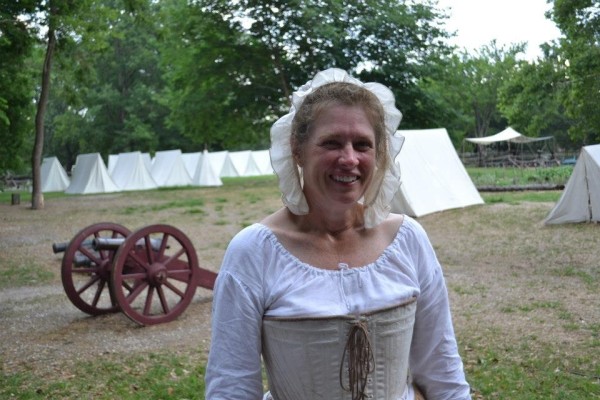
Today, Carrie MacDougall is wearing a shift, stays, a petticoat, and an apron. That’s how you know she is portraying a camp follower. You see, if she were wearing breeches and carrying a firearm, she would be playing a member of the Virginia militia—in other words, a man. Her hair would be tucked up and she would be doing the work of the colony’s citizen soldiers.
On the days she is a camp follower, Carrie talks about who these women were and demonstrates some of the roles they played in military life.
Every army had its followers, even the Hessian mercenaries hired by the British during the Revolution. Technically camp followers included men, women, and children, but in casual usage the connotation is usually women. And it’s that image that has likely contributed to some of the misconceptions that Carrie finds herself addressing. Here are five that she hears most often:
#1 Camp followers were a burden on the military
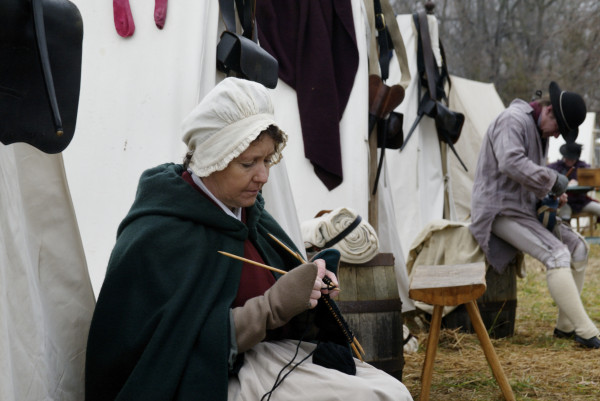
Camp followers were technically any non-military persons who attached themselves to a group of soldiers. They supplied many of the military’s needs, oftentimes performing domestic duties, but also serving as masons, wagoners, drovers, and other necessary services.
Military orders often included directives like, “The baggage will follow in the rear.” That included supplies, but also the followers. The soldiers marched in front, the civilians in back. It’s easy to imagine a straggling horde of women trailing the more disciplined soldiers.
In August of 1777 George Washington, as commander of the Continental Army, wrote: “The multitude of women in particular, especially those who are pregnant, or have children, are a clog upon every movement. The Commander in Chief therefore earnestly recommends it to the officers commanding brigades and corps, to use every reasonable method in their power to get rid of all such as are not absolutely necessary.”
Carrie believes that Washington might not have wanted camp followers to be there, but he eventually recognized their value. He needed them.
By January of 1783, he seemed to have changed his tune, writing that he was “obliged to give provisions to the extra women in these regiments, or lose by desertion some of the oldest and best soldiers in the service.”
Military operations could not, and did not, function without camp followers.
#2 Camp followers were prostitutes
Only a small minority of people around a military encampment would have been considered women of “loose moral character,” (to use 18th-century phraseology).
Prostitution was more of an issue when armies were in cities where it tended to be tolerated more than elsewhere. In fact, camp women were required to undergo inspections by the surgeon to make sure they didn’t have any communicable diseases. Now if the woman was a soldier’s wife, the surgeon would instead inspect the man, figuring that was an equally accurate way to find gauge their health.
Any woman found to be “unclean” would be sent out of camp.
In 1777 Washington gave orders for precautions to be taken to “prevent an inundation of bad women from Philadelphia.” He also encouraged his men to seek out “clean” women, preferably with children. They were less likely to create problems.
But while camp followers were not by any means prostitutes, neither were they ladies, that is, women of some means and social standing. Such women tended to spend time with their officer husbands when the army was garrisoned for the winter, especially in a city. Martha Washington famously joined her husband at Valley Forge, but you wouldn’t have found women with her status trailing around with the “baggage” that Joseph Plumb Martin later compared to “a caravan of wild beasts.”
For Martin camp followers “beggared description”: they were “some in rags and some in jags,” but none “in velvet gowns.” In other words, a rough lot.
#3 Women did all the cooking
There’s a common notion that women were standing there cooking and men would line up to eat, but that’s not how the system worked. In general, a tent housed six men, to whom the quartermaster would distribute food rations every other day. One soldier was designated as the cook for his mess unless a soldier’s wife was available to do it. If a woman could be hired to do the cooking for a mess, that freed up a soldier for other duties.
The women in camp weren’t members of the military, but they did have to work. They were paid by soldiers for performing various tasks, usually by the piece. Laundry was the most common work (and officers paid better than enlisted men), and they also did a great deal of cooking, mending, and nursing.
An estimated three percent of the people in military camps were women following soldiers, accompanying husbands, brothers, and sons. “Most were displaced. They didn’t have anywhere else to live. It certainly wasn’t an easy life,” says Carrie.
But female camp followers also made war more tolerable by creating some semblance of home under difficult circumstances.
#4 Molly Pitcher was a real person

An entire mythology has risen around the story of Molly Pitcher, the woman who supposedly took up the cannon when her husband fell on the battlefield. It resonates as a story of a heroic woman as loyal to the Revolutionary cause as she was to her man. As with so many myths, there are elements of truth to the story, but there was not, historians generally agree, any single person with that name.
Private Joseph Plumb Martin first wrote of a “Molly Pitcher” in 1828. He was recollecting the Battle of Monmouth in 1777 (more than half a century earlier). He recalled: “A woman whose husband belonged to the artillery and who was then attached to a piece in the engagement, attended with her husband at the piece the whole time. While in the act of reaching a cartridge and having one of her feet as far before the other as she could step, a cannon shot from the enemy passed directly between her legs without doing any other damage than carrying away all the lower part of her petticoat. Looking at it with apparent unconcern, she observed that it was lucky it did not pass a little higher, for in that case it might have carried away something else, and continued her occupation.”
This was in all likelihood Mary Ludwig Hayes McCauley, but the tale get better in every telling. Sometimes it includes elements from the story of Margaret Corbin, who helped defend Fort Washington in Manhattan in 1776. She earned a pension and was known as “Captain Molly.”
But for Carrie, Molly Pitcher is just a camp follower story, in which a woman steps in to help a family member.
#5 Women enlisted in the military as men
Carrie says that this is one that the women in military programs talk about every day. They are, after all, usually dressed like 18th-century male soldiers.
A few women did conceal their gender and enlist as soldiers. The most famous example is Deborah Sampson, who was injured in battle yet still managed to hide her secret until a doctor treating an illness discovered the truth.
“This was not as frequent as people want to believe,” says Carrie. “I can document few actual women who dressed as men. The rest of them were probably camp followers who put on the garb of the soldier.”
But what was “the garb of the soldier”? Did that mean breeches, or was it just a cartridge box or a bayonet scabbard over one’s dress? Carrie suspects it was the latter. Women simply weren’t tolerated in the military. And Carrie’s experience dressing like a man has convinced her that it would have been very difficult to conceal one’s gender for long.
Visit Carrie and her colleagues at the Magazine to learn much more about camp followers and other aspects of military life during the American Revolution. You can also visit the Guardhouse next door for Military Distaff: The Fairer Side of the Army. The program will be offered every Tuesday and Thursday at noon this month. Click here for the full slate of Women’s History Month programs.
And if you want to learn more before or after your visit, Carrie recommends primary sources, such as the narrative of Joseph Plumb Martin, as the very best insights into military lives. But she also leans heavily on two books about camp followers: Nancy K. Loane’s Following the Drum and Holly Mayer’s Belonging to the Army. And here’s a fun fact: Professor Mayer once worked as a camp follower at Colonial Williamsburg.
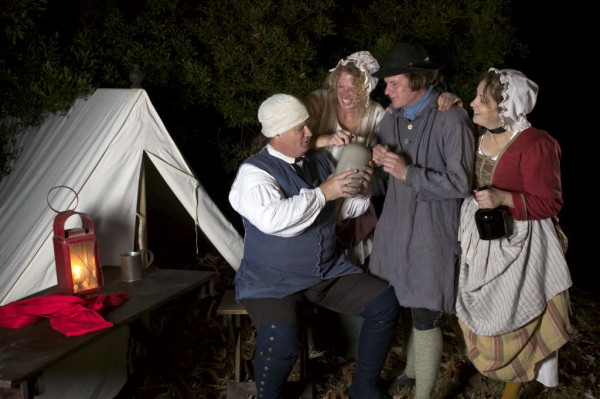
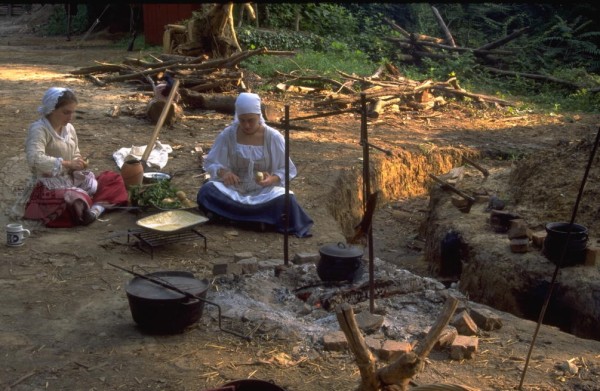
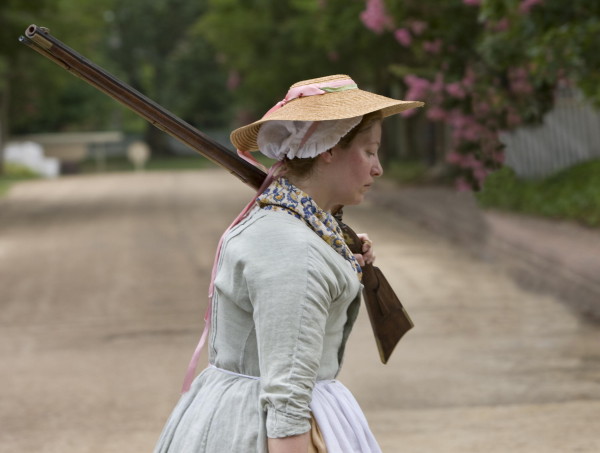
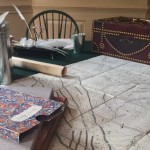
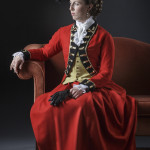
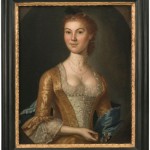
My husband and I plus several friends took a side trip on our last visit to Gettysburg to see the grave of Molly Pitcher in Carlyle Pennsylvania. We also visited graves of many Revolutionary soldiers and officers.
Will Tatum says
How common would it have been to see female followers in camp without a bedgown or some other covering on over their stays and underpinnings? Was it common for followers to knit in camp? How frequently would women have interacted with firearms during the eighteenth century?
Thank you very much for reading the CW blog, and I hope that you are able to attend “Distaff - The Softer Side of The Military” being held every Tuesday and Thursday at the Guard House at noon - 1.
In answer to your questions:
1. Do campfollowers muck about in their stays? Yes, while I am working and it is hot, most certainly. However, never would I go to market without proper attire, or anywhere else for that matter!!
2. Do camp followers knit? knitting is one of the skills that is very portable. Geo. Washington’s grandson wrote that Martha Washington was knitting in camp..although he has added a lot to the myths of the American Revolution so his contributions should be studied with skepticism, it is very possible that women were knitting in camp, I have not found any first person mention of it. They were very busy doing laundry, cooking, mending, and looking after children, it is still feasible that knitting to create warm apparel is happening. If this is an interpretation that is being considered, just make sure you are using knitting pins (not needles) and they are made of steel or bone.
3. These women are a pretty sturdy lot. They have for the most part come from farms (90% of the population in Virginia at this this is involved in the business of farming), as such, just about everyone will have handled a gun at some point, probably a fowler or riffle. The musket is fairly easy to load, same principle as the other two, just faster!!! We also have lots of documentation of women rolling cartridges to help the war effort. Again, I can actually document only a few women in battle taking up arms and using them, but my personal theory is that just about everyone knows how they work.
I hope this helps with your questions, if not, or if it has inspired more, please feel free to contact me.
Sincerely,
Carrie MacDougall
Military Programs
Camp follower
cmacdougal@cwf.org
Great post! Molly Pitcher’s one of my favorite stories!
Your readers might also be interested to know that on Thursday March 10, 2016 Colonial Williamsburg is broadcasting “Women of the Revolution” live at 10 a.m. Eastern and 1 p.m. Eastern. Any reader can tune in (go to history.org/HERO to find a broadcaster in the area) or register (free!) for the live-stream online.
The program is designed for students in the 4th through 8th grades. Students in registered schools can call, tweet, or email questions to be answered during the broadcast by Colonial Williamsburg historians and character interpreters.